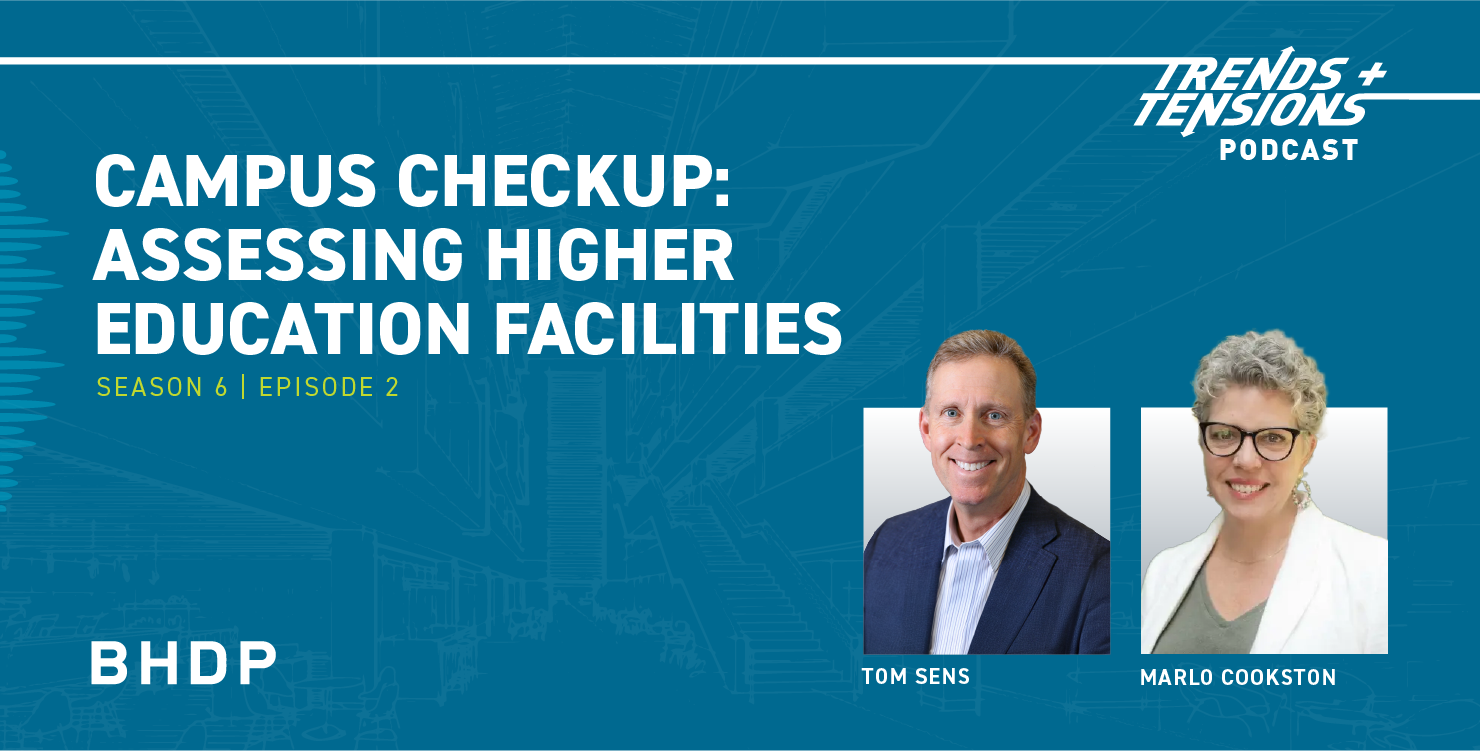
Futureproof: Integrating Strategic and Master Planning within Higher Ed

Want to listen on another platform? Choose your platform here.
Episode Transcript
[Music Intro]
Brain Trainer, Host: Welcome to Trends + Tensions in Architecture and Design, presented by BHDP, where we discuss Trends in Architectural and Interior design and the competing priorities or Tensions that arise from integrating new ideas into existing organizations, enterprises, and institutions. In this episode, “Futureproof: Integrating Strategic and Master Planning within Higher Ed,” we are joined by John Stevens, President of Stevens Strategy, Jamie Caridi, President of Terra Firma Consulting, and Paul Orban, Managing Partner at BHDP. I am your host, Brian Trainer, senior strategist for BHDP. Let’s get started.
Brian: We're talking about integrated, strategic, and master plans in higher education specifically. We have a couple of guests with us today, and I want to let them introduce themselves and tell us who they are and what they do. So, John Stevens, I'd like to start with you.
John Stevens: Thank you very much. I'm John Stevens, President of Stevens Strategy. We're a firm that's been around since the turn of this millennium, and that's only 25 years. We focus on vision, strategy, governance, financial analysis, marketing, and policy development for colleges and universities principally.
Brian: Great. Thank you for that. Jamie Caridi, tell us who you are and what you do.
Jamie Caridi: Thanks for having me today. I am the president of Terra Firma Consulting, which is a higher education consulting practice. Like John, we help institutions with strategic planning and financial planning. A core focus of ours is institutional turnaround and renewal. Through that work, I also happen to be serving in my fourth year as president of Bethany College in West Virginia.
Brian: Very cool. Welcome to the program, and thank you for joining us again. Paul Orban, remind people who you are.
Paul Orban: Hey, thanks, Brian. I'm Paul Orban. I lead the higher education practice for BHDP. I've been focused on this piece of business for almost 25 years. BHDP works with higher education institutions, develops their campus strategy, master plans, and provides full architectural and planning services for our clients.
Brian: Welcome back, Paul. We're talking about integrated, strategic, and master plans today, so my first question is: What is an integrated, strategic, and master plan? If you wouldn't mind, I'd like to kick that over to John first.
John: Strategic planning is a newbie. It doesn't seem like that. It's been around for about 50 years, but master planning has been done for centuries. At the beginning, master planning was developing essentially what Dick Dober called a “manifest destiny for an institution”. It wasn't terribly strategic; it was aspirational. Strategic planning is a very strategic activity. It's looking at the external environment, internal strengths and weaknesses, opportunities and threats, and developing a plan that adjusts to those external factors. As time went on, strategic planning and master planning were done together. Typically, when an institution renews its master plan, it also considers a new strategic plan. So, the master plan becomes more strategic, but it deals with the physical facilities and the opportunities for adjacent property and things like that, while the strategic plan is more focused on markets and changes in the marketplace for other institutions.
Jamie: Yeah, I think John laid an incredible foundation, and we've been doing it a long time, and he's been doing it a really long time. And so he really is, in some respects, the architect of higher education, master planning, and really privileged to be with them today. I think integrated strategic and master planning is a way of, as John said, bringing these two, what used to be separate exercises, together, because I think there was a recognition that the synchronization of these two entities or endeavors is critically important in a world where there are just fewer resources. And I think many colleges, boards of trustees, and management teams would find that they had these aspirational master plans that they frankly couldn't afford, or in some cases could afford and would build, but that had nothing to do with their strategic goals, which are meeting the needs of the marketplace.
Of course, when that happens, the marketplace loses confidence in an entity or an institution. So, integrated, strategic, and master planning is a way to synchronize an institution's vision, academic portfolio, finances, enrollment strategy, campus facilities, and physical infrastructure in a meaningful and relevant way in today's world.
John: A couple of years ago, my firm worked with a university in the Midwest that had completed a master plan, erected some buildings, and bought some property adjacent to the campus, but didn't have an active strategic plan. They asked us to do a strategic plan a couple of years after they had made all these advancements with their property. We found out that they didn't have a market to support some of the programs and some of the facilities that they had built. So, they really had to backstep and do some additional thinking and changes to account for the financial weakness that building those buildings without an adjacent strategic plan had. So, it's very important nowadays to do it together.
Paul: Brian, I wanted to comment on just the term integrated because I think that's a key to this conversation. About a year and a half ago, we did a national survey of college presidents and CFOs on this topic, asking about their strategic planning, their master plan, the status, and so on. And one of the things that stood out to us in that survey data was that only half of the presidents and CFOs felt like their strategic plan and their campus master plan were related or linked, there was a relationship, or they were coordinated. I think this whole idea that they're integrated, meaning they're supporting each other, they're sharing similar goals; one's talking about strategy, and one's talking about the implementation of the physical environment, is really important because otherwise you could have two very separate and different documents that aren't really gonna advance the institution at all.
Jamie: No, Paul makes a great point. The research BHDP did is supported by equivalent research that the Society of College and University Planning did, which showed that only 25% of institutions report that their strategic plan and their campus master plan have a strong correlation. That results in, of course, failing the marketplace. Every institution in America, I don't care if you're public, private, nonprofit, or for-profit, the reason you exist is to serve the needs of your community. And when you don't do that, you tend to face an existential crisis. So, this integration of the two is critically important. Really good point. Paul,
Brian: What are the other values that integrating a strategic and a master plan brings to a university?
Paul: I think the first thing I would start with Brian, from experience, we sometimes see a strategic plan that talks about adding an academic program for the growth of the institution, but has no clear way to implement that in the physical environment. Meaning, where's that gonna go? If we're growing enrollment, we have residence hall capacity and dining capacity for those students. Where does the academic program lie? Let's say it's a health science program. We need nursing labs. Have we considered the fact that this is also gonna now trickle down to an additional load in our basic science classes, right? Because those new students are taking that, you could see that type of disjointed situation at the same point.
You could have a campus that has space, campus assets, extra space, and a uniqueness that hasn't been considered in terms of how that could become an asset in this overall strategic plan. So, suppose you're treating them as two different documents and processes. In that case, you're not necessarily seeing the potential gains of efficiencies or maybe even just serendipity of, “hey, wow, we're looking to add a program, and by the way, we have some underutilized space on campus that we could grow that program with less investment”. I think it's important that you're really starting to align those or coordinate 'em to look both ways at those opportunities, synergies that could help the institution.
Brian: The two different plans are the strategic plan and the master plan. How do they inform each other?
John: Often, recently, they're being done simultaneously. A good strategic plan always considers the physical plant and what needs to be done to it. But it doesn't go into the kind of detail that a master plan would. So Paul discussed the problem of having a strategic plan without a master plan, and I described the problem of having a master plan without a strategic plan. It's best to do them either together or in quick sequence. If you're going to do one first, I would say probably the strategic plan, and then immediately redo the master plan. Paul might disagree and suggest they go in the other direction, but it's very important that they be done close together and in sync.
Jamie: I think that's a really good point, John. I would say, as a reminder, what is strategic planning? It's defining the mission, vision, and values of an institution, and then it's defining near-term and midterm goals around how you'll live out those values. For a higher education institution, that means primarily academic programs, but it also includes some ancillary programs. But to your point and question of how they are integrated, you can imagine that in a strategic planning process, you have to ask yourself the question, what should we be doing?
Individuals and organizations need to ask themselves three questions: What am I passionate about? What are we good at? What are our gifts? And what are the needs of the community and those we serve? I think those are three important questions. As part of strategic planning, higher education is known to be changing by addition, where they keep trying to do more with less. Eventually, you're not doing anything particularly well. We happen to use an exercise—I'm sure John does as well—when we do strategic planning called Start, Stop, Continue. What should we start doing? What should we stop doing? What should we continue doing? And everybody stares at the stop board and has no idea how to populate it because organizations really struggle with that question.
But once you do that needs analysis, which by the way isn't in a vacuum. You should be working with your community and a variety of constituencies during the strategic planning process, including doing true market analysis, which I know John's firm and my firm both do. Once you understand what the needs of the community are, you then need to understand how you can, with your limited resources, build out an infrastructure, optimize an infrastructure to meet those needs, and deliver those programs. That's why you really have to do it together, because you're gonna identify your priorities and resources, and at a certain point, you stop. Because your resources get spread too thin, and that's why they're important to do together.
Brian: If you were to start from scratch, so say a university came to you and said, listen, we're interested in this, but we don't know where to start. What's step one in doing this integrated strategic and master plan process? And then what's the critical path forward? If you could have an ideal situation, where would you recommend people start?
John: Where I would start is with the process that was most recently completed, to see the direction of that thinking, and then respond to it with either the strategic or the master plan that would follow that lead.
Brian: Once you've begun, what are some essential steps to take to make it a successful integrated plan?
Jamie: I'd be happy to offer a couple of thoughts in this regard. First of all, I think by way of getting started, you have to have situational awareness. You have to understand what's going on around you, which means you have to typically involve a variety of constituencies in that strategic and master planning process.
Number one, they're going to help you identify your priorities, for sure. You need to bring quantitative data to the table. Focus groups are an important part, but bringing the quantitative research to the table and backing anecdotal information up with facts is really important as part of this process. Then you have to make sense of what you have found through focus groups and through the data. That sense-making process is really important, and it helps identify and emerge what the priorities are. And then from that, I would just say once you identify your goals and your KPIs around those goals, a really important part of the responsibility of management teams and governing boards is to develop operational plans and financial plans that support both the strategic and master plan.
We've all heard it, that lots of time and energy are put into strategic and master planning. The community comes together, and then the community gets very frustrated 'cause they're put on the shelf and never acted upon, and everybody goes back and lives their normal lives. So, it's incumbent upon CEOs, presidents, and boards of trustees, alongside a strategic and master plan, to have a highly functional operational and financial plan that is going to make sure that the strategic and master plan gets fulfilled.
Brian: Who are the key stakeholders that will help move this forward?
John: To do the job that Jamie mentioned, all of those steps are very important, and you can't miss one of them. You have to have an institution with a governance structure working reasonably well. You have to have a faculty that is not butting heads with the administration and a board that understands its governance role and the president's leadership role, and they have to be able to make decisions respecting each other's domain of authority and responsibility within the institution. If you don't have those things in place, you need to fix 'em to move forward with effective, strategic and master planning.
Jamie: I love the point John made because higher education institutions are very unique and they're peculiar and they're very different than any other organization that exists out there. If you try to answer the question, whose institution is it?
If you think of a corporation, you'd say it's the stockholders, the board, and the CEO who are in charge. You can isolate that answer pretty quickly with any other organization. When it comes to higher education, whose institution is it? You'll talk for an hour about whose institution it is. It's the students, it's the alumni, it's the faculty, it's the staff, it's the community, it's donors, it's foundations, and it's the government that have a stake in the institution in many cases. That list goes on and on. So, having a cross-functional working group as part of your strategic planning task force is critically important, and John nailed it. You know that group has to have an appreciation and a trust level for each other that's laid out, palpable, and real before you get started on endeavors such as this. Paul, wouldn't you say the same as it relates to master planning?
Paul: Absolutely. From a group of stakeholders, it's going to be a diverse cross-section of leadership and students, boards of trustees, and community members. Depending on some of the issues or things we're seeing in the process, you may form other special groups, whether it's around Pacific Charter for some alumni or others, just to understand all aspects. Look at the problem from all angles.
As we start to consider the right strategies to implement in terms of the planning process, one of the things that is important for the board when it comes down to the master plan priorities is whether they're enthusiastic about implementing them. What we saw in the research was that many institutions had a master plan with priority projects or initiatives, but there was a very low number of enthusiasm from the board, which often is where your donor base starts, or at least a big piece of that resides where those that are very important in that fundraising effort out there or however you're gonna fund it. And the point was, is if your plan is yielding priorities that the board is enthusiastic about trying to figure out how to fund, what's the reality that it's gonna get implemented at all. So that is a place where they do need to be involved, at least. Being involved toward the tail end is saying, "Hey, these are the right things that we can rally around to help the administration get them implemented."
Jamie: I have found, and we encourage at Terra Firma, institutions and leadership teams to use these opportunities of strategic and master planning to invite people to the table, particularly people who will be instrumental in carrying out and deploying the master plan.
Prospective donors are one of those constituencies. Higher education is in the press a lot these days, and typically not for good reasons. So, confidence in higher education from the government, from families, and funders has waned over these past years. We have just to acknowledge that, and it's not a misperception, by the way, from the marketplace, we have failed to deliver. Either on outcomes, or we have the outcomes, and we failed to convey what those outcomes are, even though they exist. So I think it's an opportunity to reestablish trust. And donors, these days, whether it's in higher education or other entities, don't necessarily want you to come to them with everything figured out. They want to have a seat at the table. Most donors are entrepreneurs with creative ideas who want to be in on the ground floor. It's not that it has to be their way or the highway, but there is an appropriate way to include them in these processes that, frankly, is part of the cultivation process, and it makes the work of your advancement efforts much easier down the line.
Brian: If somebody listens to this and says they work for an institution and would like to implement this, what do you hope their one takeaway is?
John: You have to prepare yourself to do it well. You have to make sure that your campus environment is focused together. There's never a total agreement, but you must have your campus environment ready for a difficult and deeply important project.
Jamie: It's somewhat the same as John's. I think commitment comes to mind. This is not something that is completed overnight. It's hard work. I would also say it's not something that needs to take forever. Higher education is known for having very lengthy strategic and master planning processes. I don't know about John, but my firm won't do that.
In corporate America, the strategic plans are usually made in a couple of months. And I think with the rapid pace of change in higher education right now, that is the track that higher education needs to be on. I heard a line the other day that never has higher education moved this fast and never will move this slow again. And that really resonated with me. And so I think this idea of commitment to hard work, an intensity around the work, a collaborative mindset going into the work, commitment of resources, which includes some time and money to not only complete the plan, but to know that you're gonna need to commit to the execution side as well. But there's help out there to do it, of course. You happen to have a couple of firms here and there, and there are others out there that can help institutions through this, and it's important work.
Paul: Yeah. Brian, I would say from a campus planner's perspective, make sure you hire somebody with the experience and the understanding of, I'll say, the business of higher education, who understands how to bring a strategic and critical eye to your campus and your facilities.
Otherwise, you may fall into a trap of hiring somebody who's more of an order taker. Somebody who just listens and puts a lot of ideas on paper based on what he hears people want versus what he or she may hear that people really need at a strategic level. Many architects out there will say, yeah, we can do a campus plan or a master plan and throw buildings on a map and say, here you go. That's not going to get you where you need to go if you're really talking about integrated planning.
Brian: John, Jamie, Paul, thank you all for your time. Hopefully, you had fun. Thank you for sharing your expertise with us. Thanks again.
[Music Outro]
Brain: Thank you for joining Trends + Tensions in Architecture and Design, presented by BHDP, for this episode, “Futureproof: Integrating Strategic and Master Planning within Higher Ed,” with John Stevens of Stevens Strategy, Jamie Caridi of Terra Firma Consulting, and Paul Orban of BHDP. If you appreciate what you have heard, please rate, subscribe, and give us a review. I am Brian Trainer, your host, and I hope you’ll join us for another episode of Trends + Tensions to see what topics drive design.
Author
Content Type
Podcast
Date
July 28, 2025
Market
Practice
Topic
Campus Planning
Innovation




